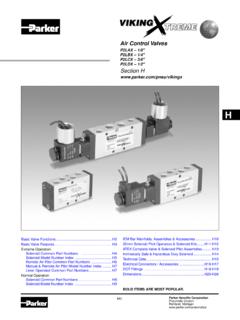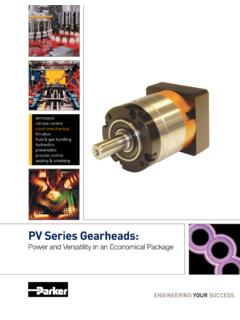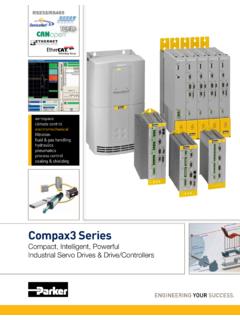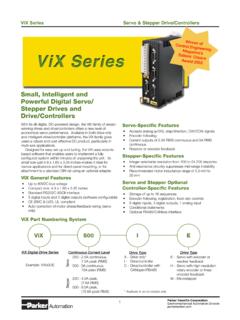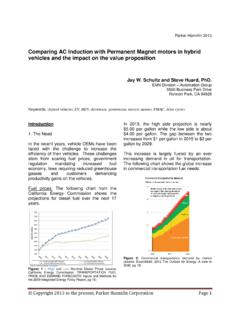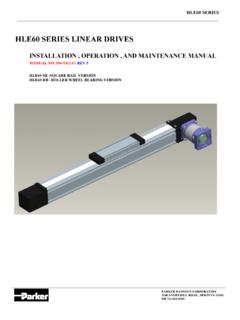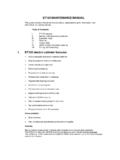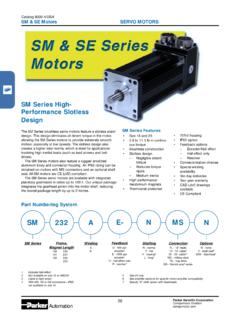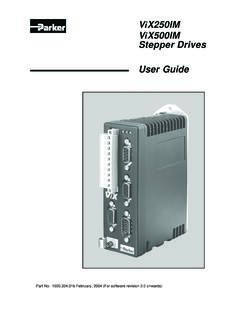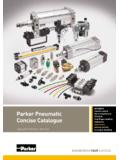Transcription of Sizing pneumatic cylinders and ISO valves
1 Page 1 of 3 Sizing pneumatic cylinders and ISO valves Look at flow coefficient, cylinder bore, and rod speed to best match pneumatic actuators and valves . Chris Landis Valve/Vacuum Product Manager Parker Hannifin Corporation Richland, Michigan In recent years, much discussion has centered on Cv ratings (also known as capacity coefficients or flow factors) and whether or not American, European, and Japanese pneumatic -valve manufacturers rate valves the same way. With ANSI/NFPA, ISO, and JIS organizations all specifying slightly different test methods and rating criteria, the confusion is understandable. Leaving that ongoing discussion to the respective standards organizations, here s a look at the practical aspects of designing the most efficient and economical system without under or oversizing components.
2 First, we ll calculate Cv for standard pneumatic cylinders and examine Cv values for standard ISO valves , including 18 and 26 mm and ISO Sizes 1, 2, and 3. We ll also chart average rod speed relative to cylinder bore size to pinpoint ISO valves that best match flow demands. The approach is based on standard Cv calculation: where Q = volumetric flow rate in standard cubic feet per minute (scfm), based on atmospheric pressure and 60 F air temperature. To simplify the equation, experts typically assume a conservative pressure change between inlet and outlet ports (P1 P2) of 5 psi. For time or process-critical applications, reduce this to 2 psi. And, in many cases, a pressure drop of 10 psi is not detrimental to the application.
3 A 10-psi pressure drop permits smaller valves that lower costs and require less mounting space. To simplify calculations, let s tabulate values for a portion of the equation for 2, 5, and 10-psi pressure changes. Here, we create a constant A, defined as and list values for varying inlet gage pressures in the accompanying Basic Data table. This reduces the flow-coefficient equation to Cv = QA. In terms of cylinder volume and time, where atmospheric pressure, Pa, is assumed to be psi. Next, calculate values for compression ratio, Cr = P1/Pa, for various inlet pressures and also list values in the Basic Data table. Restating the volumetric flowrate equation in terms of compression ratio results in Now examine the impact of cylinder volume and stroke time for known Cv values of ISO valves .
4 Given that Cv = QA; and V = ( /4)d2l, we can restate the equation as: Here, l/t is a simplified representation of average rod velocity in inches per second. This equation works well for NFPA cylinders . But because designers usually specify ISO cylinders in metric units, apply the conversion factor 1 in. = mm and revise the equation: Assuming 80 psig for inlet pressure based on a typical plant operating at 100 psig with line losses and using a conservative 5-psi pressure drop for the constant A, chart average cylinder rod speed versus cylinder diameter in terms of required Cv. The accompanying tables for two and three position valves highlight areas where each ISO valve meets Cv requirements. Nomenclature d = cylinder diameter, in.
5 G = Specific gravity of the fluid (G = 1 for air) l = cylinder length, in. P1 = Absolute pressure at inlet port (gage pressure + ), psi P2 = Absolute pressure at outlet port, psi Pa = Atmospheric pressure, psi Q = Volumetric flow rate, scfm T = Absolute temperature of air, R t = Time to fill cylinder , sec V = cylinder volume, Page 2 of 3 Parker s Isysnet Field Bus System includes a valve drive module that controls up to 32 solenoids; I/O modules with up to 256 inputs and 256 outputs; and communications modules using EtherNet/IP, ControlNet, DeviceNet, and Profibus DP. The plug-in pneumatic valves meet ISO 15407 and 5599 dimensional and electrical standards. Cv VALUES FOR TWO-POSITION valves These tables chart flow requirements based on cylinder size and average rod speed.
6 The large table highlights two-position ISO valves that meet the needed Cv, assuming 80 PSI inlet pressure and 5 PSI pressure drop. Page 3 of 3 VALVE RATINGS CV Values ISO Valve Size PH Designation Two Position Three Position 18 mm HB 26 mm HA Size 1 H1 Size 2 H2 Size 3 H3 These tables chart flow requirements based on cylinder size and average rod speed. The large table highlights two position ISO valves that meet the needed Cv. BASIC DATA A Constants Inlet Pressure (PSIG) Compression Factor 2 PSI P 5 PSI P 10 PSI P 10.
7 152 .103 -- 20 .126 .084 .065 30 .111 .073 .055 40 .100 .065 .048 50 .091 .059 .044 60 .085 .055 .040 70 .079 .051 .037 80 .075 .048 .035 90 .071 .046 .033 100 .068 .044 .032 110 .065 .042 .030 120 .063 .040 .029 130 .061 .039 .028 140 .058 .037 .027 150 .057 .036 .026 160 .055 .035 .025 170 .053 .034 .024 180 .052 .033 .024 190 .051 .032 .023 200 .050 .032 .023 The table lists compression ratios, P1/Pa, as well values for the constant A, for a range of inlet pressures and pressure drops. Parker Hannifin Corp.
